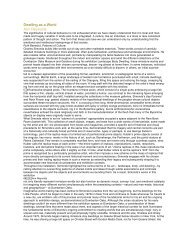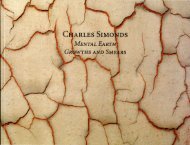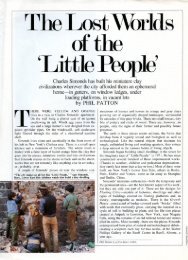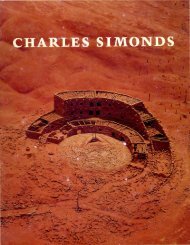Galerie Enrico Navarra
Dwellings - Charles Simonds
Dwellings - Charles Simonds
Create successful ePaper yourself
Turn your PDF publications into a flip-book with our unique Google optimized e-Paper software.
Le Monde dans le monde. Werner SpiesWorld Within World. Werner SpiesC'est au debut des annees soixante-dix que l'ona pu decouvrir le projet d'urbanisme a l'echelle du baca sable elabore par Charles Simonds. Ses Dwellings,minuscules habitations imaginaires pour une populationimaginaire, desertaient l'appartement de I' artiste. Et soudainl'on rencontrait ces constructions de terre crue enplein Manhattan, dans les anfractuosites des murs etsur les bords des fenetres. Charles Simonds avait tissece reseau tenu comme l'oiseau fait son nid. ll l'a exposesans protection aux dangers de l'environnement reel.Les lotissements minuscules deconcertaient ou enchantaientles passants. Difficile d'imaginer pire irrespectenvers Ia tradition officielle de I'Ecole de New York ouI' art des musees.Depuis, Ia frag ilite bien trop tentante des reuvres, le vandalismeet Ia negligence ont fait qu'il ne reste pas grandchosede ce que Simonds a realise au fil des ans et deses expeditions a SoHo, dans le Lower East Side, aParis, Berlin, Dublin, Venise, Shanghai ou Guilin. L'artistenous a livre un mirage d'inappartenance. Tres peu deses reuvres sont entrees dans des collections publiquesou privees. Depuis le debut. I' art de Simonds n'est pasdestine a etre possede, mais a faire naltre des souvenirsimpalpables. Son fonctionnement repose la-dessus.L'apparente insouciance de !'artiste a l'egard de sesreuvres ne fait que souligner leur message. Les lueursd'une realite passee, insaisissable, que Simonds fait miroiterdans Ia grande ville correspondent a Ia tristesseet au desarroi profonds de l'archeologue. II n'aurait paspu aller plus loin dans ce sens. D'une certaine fa9on, il.adepasse le modele archeologique. D'ailleurs, ses creationsn'ont laisse aucun vestige. Nous n'avons plus quedes photographies de ces villes et de leurs populations.Ce qui a motive Simonds, c'est Ia recherche d'un publicdifferent, mais aussi l'affrontement avec un milieu incapablede reagir devant ses reuvres autrement quepar Ia surprise ou par Ia consternation. Sa demarcherefletait alors certains schemas de comportement desannees soixante et soixante-dix visant a influer sur Iasociete par le biais de Ia distanciation et de Ia provocation.Lors d'un entretien avec Daniel Abadie, Simondsdeclarait a ce propos : «Ma maison etait remplie de lieuximaginaires et il m'a semble aussi simple de les recreerThe first view to be had of Charles Simonds'sandbox urban projects was in the early 1970s. HisDwellings, Lilliputian structures of unfired clay evokingthe lives and times of imagined peoples, left hisapartment and suddenly began to crop up in midtownManhattan, perched in wall niches or on window ledges.Simonds had built these fragile, private webs like birdsbuild their nests, and now they were exposed to thedangers of the real world. Passersby shrugged theirshoulders, or smiled, or felt an itch to destroy. An art thatshowed less respect for the official New York Schooland its galleries was hard to imagine.In the meantime, the provocative fragility of the pieces,vandalism and negligence have ensured that very little ofwhat Simonds produced during his expeditions in SoHoand the Lower East Side, in Paris, Berlin, Dublin, Venice,Shanghai or Guilin, has survived. The artist gave us amirage of non-possession. Only a handful of his pieceshave found their way into the marketplace or themuseum. Inadvertently, one should add, for Simonds'art was intended not to be coveted and hoarded, butto record diaphanous memory. This aim was crucial toits effect, and the artist's negligence with respect to hisown work only underscored the message of the project.The vision of a reality long past and buried whichSimonds brought for one shining moment into theoppressive reality of the big city was paralleled by itsdemonstration of the tristesse and ultimate hopelessnessof archaeology. In a sense, the parallel even transcendedthe archaeological paradigm, because, apartfrom the occasional photographic record, not a relic ofthe artist's cities and peoples remained.Simonds was impelled as much by a search for analternative public for art, as by the confrontation withan environment which could not help but react withsurprise or dismay to his work. His approach reflectedcertain behavioral patterns of the 1960s and 19 70s,which were motivated by an attempt to affect societythrough alienation and shock. In an interview withDaniel Abadie, Simonds commented in retrospect. "Myhouse was filled with imaginary rooms, and it seemedquite normal to recreate them outdoors, where morepeople could see them. The street was exciting and full11












